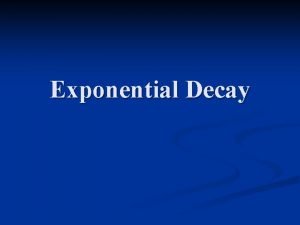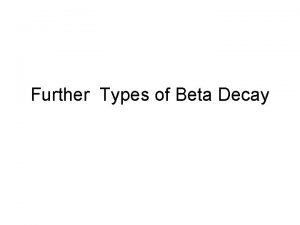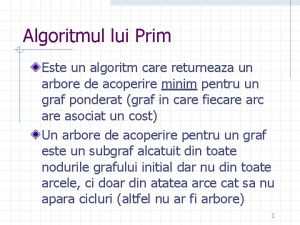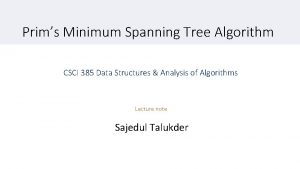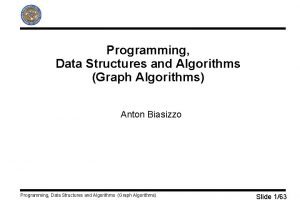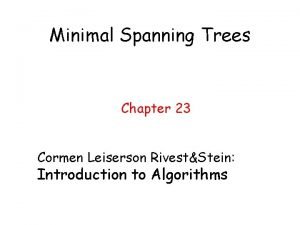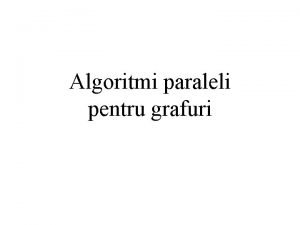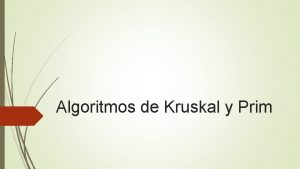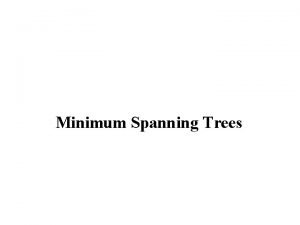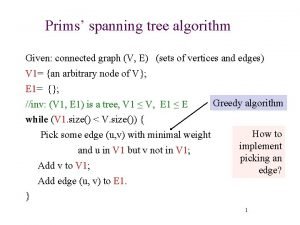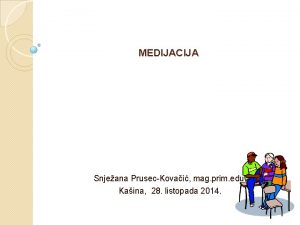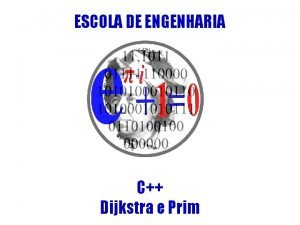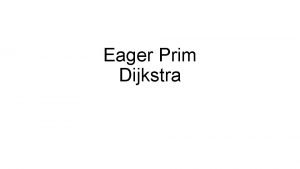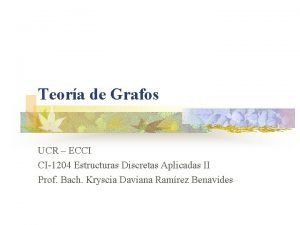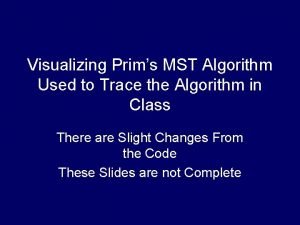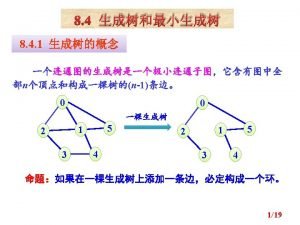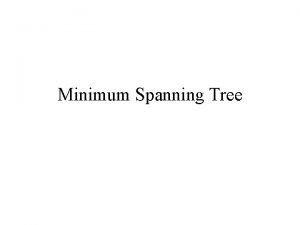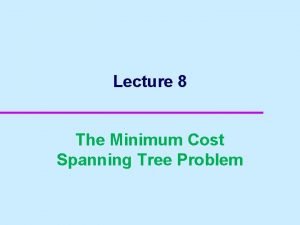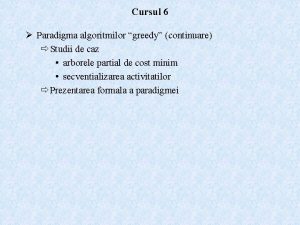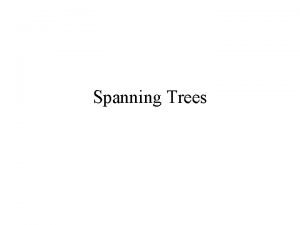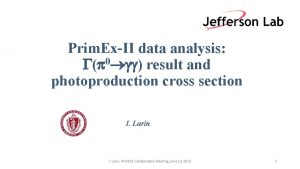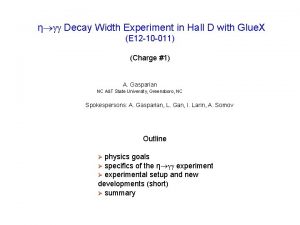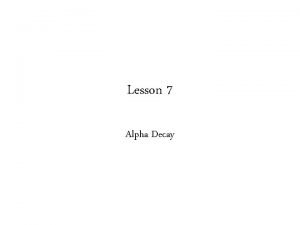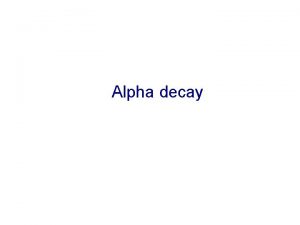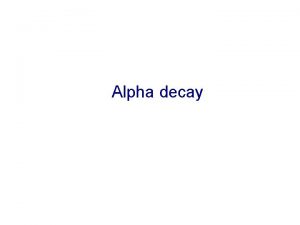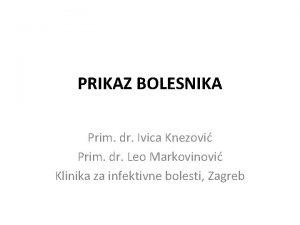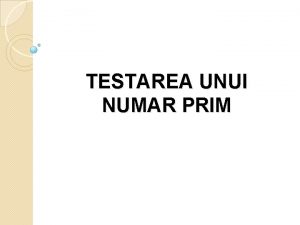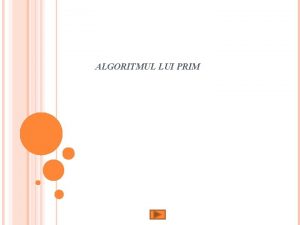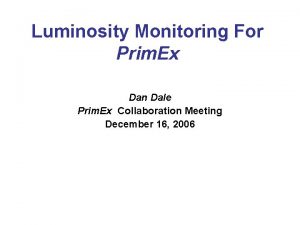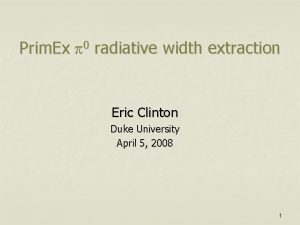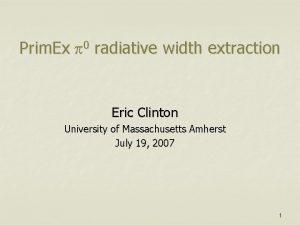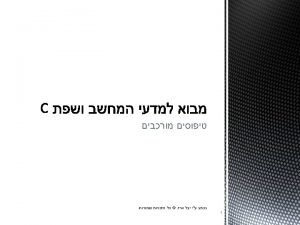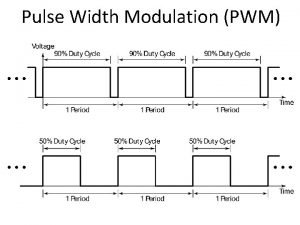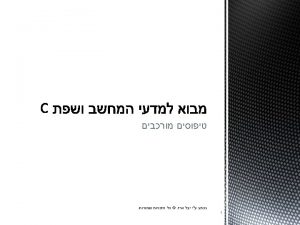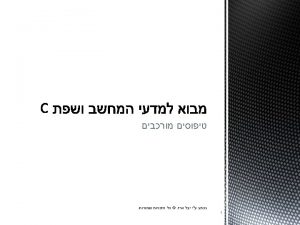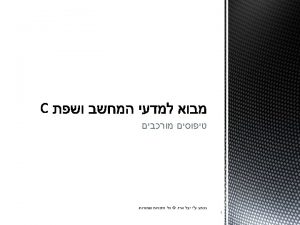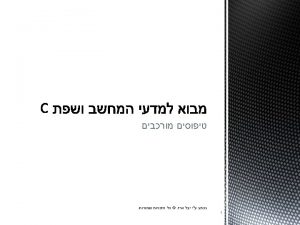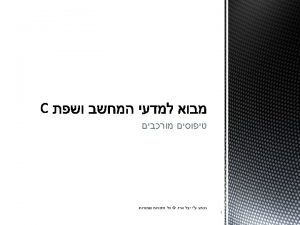0 decay width from the Prim ExII experiment

























- Slides: 25

0 π→ γγ decay width from the Prim. Ex-II experiment Ilya Larin University of Massachusetts Amherst for the Prim. Ex-II Collaboration I. Larin, Second Plenary Workshop of the Muon g-2 Theory Initiative, June 2018 1

Outline Physics motivation Experimental methods The Prim. Ex experiment Prim. Ex-II results Further experiments within 12 Ge. V program at Jefferson Lab I. Larin, Second Plenary Workshop of the Muon g-2 Theory Initiative, June 2018 2

QCD predictions for ( 0 ) § π0 γγ proceeds primarily via chiral anomaly § Chiral anomaly predicts exact value for decay width at the leading order: 0 § Next to the leading order corrections have been calculated taking into account different quark masses and mixing effects with percent level precision: § § J. Goity et al. : 8. 1 e. V± 1. 0% K. Kampf, B. Moussalam: 8. 09± 1. 4% B. Ananthanarayan et al. : 8. 06± 1. 0% B. Ioffe, A. Oganesian (QCD sum rules): 7. 93± 1. 5% I. Larin, Second Plenary Workshop of the Muon g-2 Theory Initiative, June 2018 3

( 0 ): experimental methods and measurements: Primakoff method § π0 photoproduction in nucleus coulomb field Primakoff Strong coherent Interference § Coulomb part of photoproduction cross section needs to be extracted: Strong Incoherent § Limited by accuracy of photoproduction theory § Most recent measurements (preceding Prim. Ex-II): § Cornell (1974) § Prim. Ex-I (2011) Γ(π0 γγ ) = 7. 92 e. V± 5. 3% Γ(π0 γγ ) = 7. 82 e. V± 2. 8% I. Larin, Second Plenary Workshop of the Muon g-2 Theory Initiative, June 2018 4

( 0 ): experimental methods and measurements: Direct measurement § Direct decay length measurement 0 0 § Decay length is only ~20μm at 100 Ge. V § Limited by unknown π0 momentum spectrum § No need to know production mechanism and cross section § Measurements: § CERN (1984) Γ(π0 γγ ) = 7. 34 e. V± 3. 1% § A new measurement is being planned at CERN (very exciting!) I. Larin, Second Plenary Workshop of the Muon g-2 Theory Initiative, June 2018 5

( 0 ): experimental methods and measurements: production in e+e− collisions § “Photoproduction” on virtual γ*γ* in e+e− collisions § No need to separate coulomb and strong production § Photoproduction cross section needs to be extracted § Limited by the luminosity of crossing beams accuracy § Measurements: § CBAL (1988) Γ(π0 γγ ) = 7. 75 e. V± 6. 4% I. Larin, Second Plenary Workshop of the Muon g-2 Theory Initiative, June 2018 6

( 0 ): experimental methods and measurements: π+ radiative decay measurement § Γ(π0 γγ) can be calculated from π+ eνγ radiative decay parameters § π+ eνγ decay in rest analysis § Γ(π0 γγ) extracted from vector form factor FV(0): § Measurements: § PIBETA (2009) Γ(π0 γγ ) = 7. 65 e. V± 13% I. Larin, Second Plenary Workshop of the Muon g-2 Theory Initiative, June 2018 7

( 0 ) status: theory calculations and (previous) measurements Measurement Method Result [e. V] Prim. Ex-I, 2011 Primakoff 7. 82 ± 0. 22 PIBETA, 2009 π+ decay 7. 65 ± 1. 0 CERN, 1984 Direct 7. 25 ± 0. 22 CBAL, 1988 Collider 7. 75 ± 0. 6 Cornell, 1974 Primakoff 7. 92 ± 0. 42 I. Larin, Second Plenary Workshop of the Muon g-2 Theory Initiative, June 2018 8

Prim. Ex Setup § Tagging facility: § Precise photon beam flux control § High resolution beam energy and time § Hybrid EM calorimeter: § Excellent energy, spatial and time resolution § Large geometrical acceptance § Pair spectrometer for additional flux monitoring § Ability to control apparatus systematics by QED processes I. Larin, Second Plenary Workshop of the Muon g-2 Theory Initiative, June 2018 9

Prim. Ex-I and II data chart Prim. Ex-I 208 Pb 12 C 28 Si Prim. Ex-II 12 C Prim. Ex run Target Thickness [% r. l. ] Beam flux [× 1012] I 12 C 5 1. 4 I 208 Pb 5 0. 72 II 12 C 8 2. 0 II 28 Si 10 5. 3 I. Larin, Second Plenary Workshop of the Muon g-2 Theory Initiative, June 2018 10

0 event selection Electromagnetic background π I. Larin, Second Plenary Workshop of the Muon g-2 Theory Initiative, June 2018 0 π ve ction i s u l Exc oprodu t o h p 11

“Hybrid” mass Energy constraint mass Elasticity Invariant mass Elastic 0 yield extraction I. Larin, Second Plenary Workshop of the Muon g-2 Theory Initiative, June 2018 12

Comparison of two methods Carbon-12 Silicon-28 - Hybrid mass - Constrained mass Extracted π0 yield up to 2. 5 deg. I. Larin, Second Plenary Workshop of the Muon g-2 Theory Initiative, June 2018 method 12 C 28 Si Hybrid mass 83, 751 165, 329 Constr. mass 84. 015 165, 736 13

Differential cross section vs production angle 28 Si 12 C § 4. 45 Ge. V… 5. 3 Ge. V photon beam energy range § 0. 02° bin size I. Larin, Second Plenary Workshop of the Muon g-2 Theory Initiative, June 2018 14

Fit to extract ( 0 ) Theory functions have been folded with experimental resolution and setup acceptance to fit the data 28 Si I. Larin, Second Plenary Workshop of the Muon g-2 Theory Initiative, June 2018 12 C 15

Nuclear density models tried for Form Factors calculations § I. Larin, Second Plenary Workshop of the Muon g-2 Theory Initiative, June 2018 16

Model parameter: strong nucleus radius nominal 5% inflated nuclear density π0 yield fit curves Fit 2/Ndof dependence vs strong radius inflation [%] Obtained cross section has few times less statistical uncertainty than Prim. Ex-I data and is sensitive to nucleus strong radius with (sub) percent level precision I. Larin, Second Plenary Workshop of the Muon g-2 Theory Initiative, June 2018 17

“Second step” contribution (“shadowing” effect) I. Larin, Second Plenary Workshop of the Muon g-2 Theory Initiative, June 2018 18

0 yield fit, Silicon target 0. 01° binning 0. 02° binning I. Larin, Second Plenary Workshop of the Muon g-2 Theory Initiative, June 2018 0. 03° binning 19

0 yield fit, Carbon target 0. 01° binning 0. 02° binning I. Larin, Second Plenary Workshop of the Muon g-2 Theory Initiative, June 2018 0. 03° binning 20

( 0 ) value vs Strong radius increase Radius increase, minimizing χ2: § Si +2. 18% ± 0. 63% § C +2. 54% ± 1. 86% has been used in the final result, statistical uncertainty of this procedure is going directly to theory systematics I. Larin, Second Plenary Workshop of the Muon g-2 Theory Initiative, June 2018 21

beam yield extraction Monte Carlo target Q DA 0. 24% 0. 17% 0. 034% 0. 05% 0. 45% 0. 02% 0. 55% 0 on Target absorption Pi 0 angular resolution Pi 0 two gamma decay branching Calorimeter geometry Calorimeter energy response Limited statistics Total Photon Beam Flux lecti 0. 4% 0. 2% 0. 55% 0. 09% 0. 2% 0. 12% 0. 94% nt se Background shape Fitting range Empty target subtraction Fit parameter uncertainty Signal count method Omega/rho background subtraction Bin migration at zero angle d. N/dθ binning 0. 01°, 0. 02°, 0. 03° Total Eve 0. 1% 0. 31% 0. 08% ≤ 0. 1% 0. 14% 0. 36% ory The πN cross section and phase Shadowing effect amplitude Nuclear coherent shape Incoherent model Non-zero spin admixture Nuclear strong vs EM radius Total Prim. Ex-II ( 0 ) systematic uncertainty I. Larin, Second Plenary Workshop of the Muon g-2 Theory Initiative, June 2018 Energy Position Slope Width Total 0. 14% 0. 07% 0. 08% 0. 12% 0. 22% Absolute tagging ratio Electron counting Beam collimation Relative tagging ratio Total 0. 37% 0. 55% 0. 18% 0. 4% 0. 80% Density Thickness Purity Total 0. 35% 0. 03% <0. 01% 0. 35% Trigger efficiency ADC errors Dead channels Total <0. 1% Gamma energy cut Pion energy cut Time window Wrong beam candidate Total 0. 13% <0. 1% 0. 05% 0. 10% 0. 18% 22

Updated ( 0 ) status: with Prim. Ex-II measurement added Prim. Ex-II combined result for two targets averaged over two analyses: ( 0 ) = 7. 80 e. V ± 0. 13 e. V, (1. 7% total uncertainty) I. Larin, Second Plenary Workshop of the Muon g-2 Theory Initiative, June 2018 23

Planned and scheduled future experiment at Jefferson Lab § Precision measurement of two photon decay width (photon beam, Hall D, with upgraded Glue. X detector): § Γ(η→γγ) scheduled to run in 2019 § Γ(η′→γγ) proposal is being prepared for Program Advisory Committee § Transition Form Factors at low q 2~0. 001… 0. 5 Ge. V 2/c 2 (electron beam, Hall B): § Γ(γγ*→π0) § Γ(γγ*→η) part of approved 12 Ge. V program § Γ(γγ*→η′) } I. Larin, Second Plenary Workshop of the Muon g-2 Theory Initiative, June 2018 24

Summary Two Prim. Ex experiments have been successfully carried out Compton cross section measurement verifies Prim. Ex systematical uncertainty for the cross section on the 1. 5% level (related Ph. D defended in May 2018) Prim. Ex-II reduced measurement error below 2% (one of two analyses related Ph. D defended in February 2018) Result has been recently approved by the Prim. Ex-II Collaboration: 0 = 7. 80 e. V ± 0. 7% stat. ± 1. 5% syst. (1. 7% total) This experiment was supported in part by NSF MRI PHY 0079840 and RFBR 18 -02 -00938 A I. Larin, Second Plenary Workshop of the Muon g-2 Theory Initiative, June 2018 25
 How to find the decay factor
How to find the decay factor Beta plus decay
Beta plus decay Algoritmul lui prim
Algoritmul lui prim Mst prim algorithm pseudocode
Mst prim algorithm pseudocode Prim's algorithm
Prim's algorithm Prim's algorithm
Prim's algorithm Patrick danville dark tower
Patrick danville dark tower Mst prim algorithm pseudocode
Mst prim algorithm pseudocode Algoritmul lui prim
Algoritmul lui prim M.y.ö. sigortası
M.y.ö. sigortası Algoritmo de prim c++
Algoritmo de prim c++ Mst
Mst Difference between prims and kruskal
Difference between prims and kruskal Prim edu
Prim edu Algoritmo de dijkstra em c
Algoritmo de dijkstra em c Dijkstra tree
Dijkstra tree Algoritmo de prim pseudocodigo
Algoritmo de prim pseudocodigo Prims algorithm visualization
Prims algorithm visualization Algoritma prim dan kruskal
Algoritma prim dan kruskal Define:inf
Define:inf Prim's algorithm pseudocode
Prim's algorithm pseudocode Prim's algorithm animation
Prim's algorithm animation ø matematica
ø matematica Prim's algorithm maze generation
Prim's algorithm maze generation Time complexity of prims algorithm
Time complexity of prims algorithm Uses crt
Uses crt
